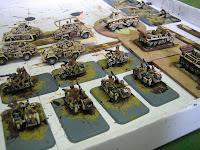Before I start, and to prevent a pointless waste of peoples time posting corrective comments, I wish to explain the organisation of this formation. As most of you will know I have chosen to recreate my formations at a figure scale of approximately 1:5, and this being the case I will have to fudge and change some organisational details; none more so than for this formation. Instead of the usual company level unit organisation I have chosen to field the armoured car company in small 'battle groups' combining other battalion assets. There should be 4 armoured car groups based around the four A/C platoons in the battalion, each with attached motorcyclists, but this would be hard to scale into three stands per 'battle group' without making the overall battalion too powerful - so I have done only three. There should also be less SdKfz 231 armoured cars but I wanted a distinguishable 'heavy' unit. The battalion's support company weapons (a 7.5cm infantry gun and a PaK36) will be split up and added to a battle group for a 'combat adjustment'. Purists will want to hang me, but they will have to find me first.
Except for some gun crew, this is what the battalion will look like.
This is how I got there.....
Step 1: Preparation.
i]. Build the models using super glue.
ii]. Add radio antenna where appropriate using a fine drill, plastic brush bristles and super glue.
iii]. Stick vehicles to painting bases using small amounts of UHU and vehicles to ice lolly sticks with a glue gun.

Step 2: Undercoat
Normally I would undercoat using black spray paint, but to get a better variation in 'base' colour I'm undercoating manually using 2 coats of Humbrol enamel, in this case number 225.
Step 3: Ink wash
All vehicles are given a good coating of acrylic ink. This is Liquitex transparent burnt umber.
Step 4: Dry brush
Everything gets dry brushed with enamel. This is Humbrol number 93. This gives the basic 'used' look by varying the shade of what is, to all intents and purposes, the base colour.

Step 5: First highlight
Using the dry brush colour (H 93) the first highlight is applied by over painting most of the dry brushed areas, but obviously staying away from darkly shaded areas. The first picture shows two SdKfz 231s, the one in the foreground has been highlighted.
Step 6: Ink detail
My next step is to go back over very deep shadow and around model detail, such as hatches, by painting with burnt umber ink. Ink flows extremely well so this job is easily accomplished with a fine brush.
Step 7: Second highlight
This is simply a case of going over most of the first highlight with a lighter shade (I used H 94). It is the time to tidy the edges and lessen the thickness of the ink lines - painting to a line is easier than pianting one.

Step 8 & 9: Last highlight and black
i]. The last highlight is applied with a brush, paying special attention to the 'corners' where two plates meet. I used H 94 mixed with H 34 (white) for this.
ii]. I paint everything that needs to be black with H33 then highlight with a grey colour.

Step 10: Bits and pieces
This is part of the finishing touches and includes adding metal tones to MGs and tracks, and painting luggage, tilts and the like using a basic three tone highlight technique.
Stage 11: Vehicle crew
Lastly I paint any human beings using various shades, and generally using a three tone highlight.
Some close ups of it all finished
That's it and I hope this might be of use to someone. It is a time consuming method that requires some skill, but I think the effort is worth it. It works very well for identifying these small vehicles and figures from war game distances.











